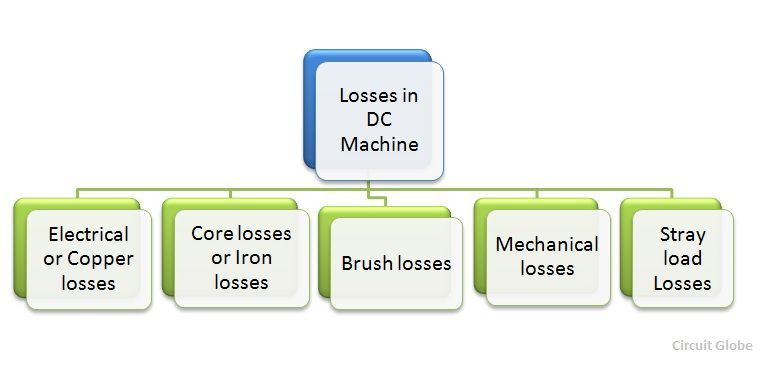The losses that occur in a DC Machine is divided into five basic categories. The various losses are Electrical or Copper losses (I2R losses), Core losses or Iron losses, Brush losses, Mechanical losses, Stray load losses. These losses are explained below in detail.
Contents:
- Electrical or Copper losses
- Magnetic Losses or Core Losses or Iron Losses
- Brush Losses
- Mechanical Losses
- Stray Losses

Electrical or Copper Losses in dc machine
These losses are also known as winding losses as the copper loss occurs because of the resistance of the windings. The ohmic loss is produced by the current flowing in the windings. The windings that are present in addition to the armature windings are the field windings, interpoles and compensating windings.
Armature copper losses = Ia2Ra where Ia is armature current, and Ra is the armature resistance. These losses are about 30 per cent of the total full load losses.
In shunt machine, the copper loss in the shunt field is I2shRsh, where Ish is the current in the shunt field, and Rsh is the resistance of the shunt field windings. The shunt regulating resistance is included in Rsh.
In a series machine, the copper loss in the series windings is I2seRse, where, Ise is the current through the series field windings, and Rse is the resistance of the series field windings.
In a Compound machine, both the shunt and the series field losses occur. These losses are almost 20 per cent of the full load losses.
Copper losses in the interpole windings are written as Ia2Ri where Ri is the resistance of the interpole windings.
Copper loss in the compensating windings if any is Ia2Rc where Rc is the resistance of compensating windings.
Magnetic Losses or Core Losses or Iron Losses in dc machine
The core losses are the hysteresis and eddy current losses. These losses are considered almost constant as the machines are usually operated at constant flux density and constant speed. These losses are about 20 per cent of the full load losses.
Brush Losses in dc machine
Brush losses are the losses taking place between the commutator and the carbon brushes. It is the power loss at the brush contact point. The brush drop depends upon the brush contact voltage drop and the armature current Ia. It is given by the equation shown below:
The voltage drop occurring over a large range of armature currents, across a set of brushes is approximately constant. If the value of the brush voltage drop is not given then it is usually assumed to be about 2 volts. Thus, the brush drop loss is taken as 2Ia.
Mechanical Losses in dc machine
The losses that take place because of the mechanical effects of the machines are known as mechanical losses. Mechanical losses are divided into bearing friction loss and windage loss. The losses occurring in the moving parts of the machine and the air present in the machine is known as Windage losses. These losses are very small.
Stray Losses in dc machine
These losses are the miscellaneous type of losses. The following factors are considered in stray load losses.
- The distortion of flux because of the armature reaction.
- Short circuit currents in the coil, undergoing commutation.
These losses are very difficult to determine. Therefore, it is necessary to assign the reasonable value of the stray loss. For most machines, stray losses are taken by convention to be one per cent of the full load output power.

nice post
Thank you maam
Good and necessary post
Nice explanation.